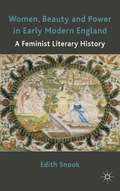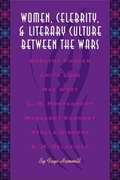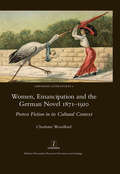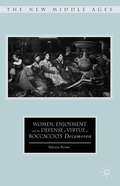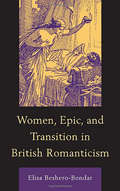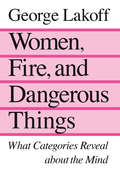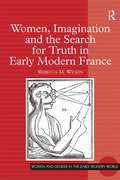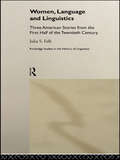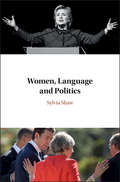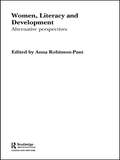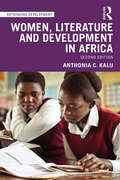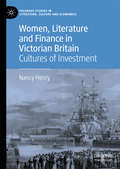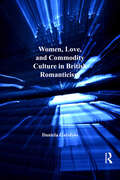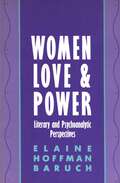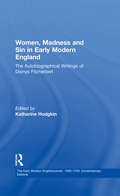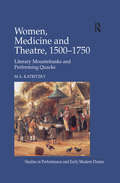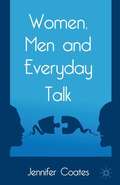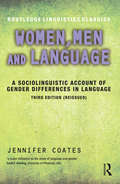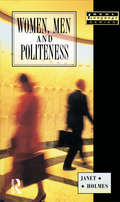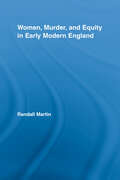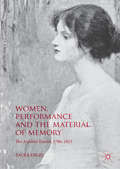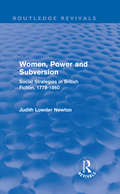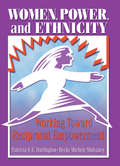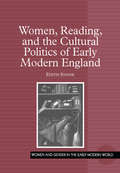- Table View
- List View
Women, Beauty and Power in Early Modern England
by Edith SnookDivided into three sections on cosmetics, clothes and hairstyling, this book explores how early modern women regarded beauty culture and in what ways skin, clothes and hair could be used to represent racial, class and gender identities, and to convey political, religious and philosophical ideals.
Women, Celebrity, and Literary Culture Between the Wars
by Faye HammillAs mass media burgeoned in the years between the first and second world wars, so did another phenomenon--celebrity. Beginning in Hollywood with the studio-orchestrated transformation of uncredited actors into brand-name stars, celebrity also spread to writers, whose personal appearances and private lives came to fascinate readers as much as their work. Women, Celebrity, and Literary Culture between the Wars profiles seven American, Canadian, and British women writers--Dorothy Parker, Anita Loos, Mae West, L. M. Montgomery, Margaret Kennedy, Stella Gibbons, and E. M. Delafield--who achieved literary celebrity in the 1920s and 1930s and whose work remains popular even today. Faye Hammill investigates how the fame and commercial success of these writers--as well as their gender--affected the literary reception of their work. She explores how women writers sought to fashion their own celebrity images through various kinds of public performance and how the media appropriated these writers for particular cultural discourses. She also reassesses the relationship between celebrity culture and literary culture, demonstrating how the commercial success of these writers caused literary elites to denigrate their writing as "middlebrow," despite the fact that their work often challenged middle-class ideals of marriage, home, and family and complicated class categories and lines of social discrimination. The first comparative study of North American and British literary celebrity, Women, Celebrity, and Literary Culture between the Wars offers a nuanced appreciation of the middlebrow in relation to modernism and popular culture.
Women, Emancipation and the German Novel 1871-1910: Protest Fiction in its Cultural Context
by Charlotte Woodford"In novels written at the end of the long nineteenth century, women in Germany and Austria engaged with some of the most pressing social questions of the modern age. Charlotte Woodford analyses a wide range of such works, many of them largely forgotten, in the context of the contemporary cultural discourses that informed their creation, such as writings on pacifism and socialism, prostitution, birth control and sexually transmitted diseases. Women's experience of contemporary medicine as patients and doctors is a fascinating theme, treated here by several authors. Through a close reading of works by Marie von Ebner-Eschenbach, Minna Kautsky, Gabriele Reuter, Helene Bohlau, Ilse Frapan, Hedwig Dohm, Lou Andreas-Salome, and others, this study shows how writers' determination to validate women's experience of the problems of modernity informed the aesthetic development of the novel by women."
Women, Enjoyment, and the Defense of Virtue in Boccaccio’s Decameron
by Valerio FermeFrom the premise that Boccaccio writes the Decameron as a go-between to aid women in love to endure the melancholy that love causes them, this book analyzes how, in the parallel world of the narration, Boccaccio's female characters employ storytelling as the "honest" entertainment with which to banish the melancholy engendered by the Black Plague, even as it helps them avoid the shameful behavior embraced by other Florentine women. This "honest" defense of their honor is challenged by the sexually explicit stories narrated by their male companions, who gradually suggest the desire to move from words to action in the overarching narrative. Through an analysis of the dynamics between the women who rule most of the first half of the Decameron and their male counterparts, the book provides novel ways in which to read Boccaccio's masterpiece within the context of late medieval society.
Women, Epic, and Transition in British Romanticism
by Elisa Beshero-BondarWomen, Epic, and Transition in British Romanticism argues that early nineteenth-century women poets contributed some of the most daring work in modernizing the epic genre. The book examines several long poems to provide perspective on women poets working with and against men in related efforts, contributing together to a Romantic movement of large-scale genre revision. Women poets challenged longstanding categorical approaches to gender and nation in the epic tradition, and they raised politically charged questions about women’s importance in moments of historical crisis. While Romantic epics did not all engage in radical questioning or undermining of authority, this study calls attention to some of the more provocative poems in their approach to gender, culture, and history. This study prioritizes long poems written by and about women during the Romantic era, and does so in context with influential epics by male contemporaries. The book takes its cue from a dramatic increase in the publication of epics in the early nineteenth-century. At their most innovative, Romantic epics provoked questions about the construction of ideological meaning and historical memory, and they centralized women’s experiences in entirely new ways to reflect on defeat, loss, and inevitable transition. For the first time the epic became an attractive genre for ambitious women poets. The book offers a timely response to recent groundbreaking scholarship on nineteenth-century epic by Herbert Tucker and Simon Dentith, and should be of interest to Romanticists and scholars of 18th- and 19th-century literature and history, gender and genre, and women’s studies. Published by University of Delaware Press. Distributed worldwide by Rutgers University Press.
Women, Fire, and Dangerous Things: What Categories Reveal about the Mind
by George Lakoff"Its publication should be a major event for cognitive linguistics and should pose a major challenge for cognitive science. In addition, it should have repercussions in a variety of disciplines, ranging from anthropology and psychology to epistemology and the philosophy of science. . . . Lakoff asks: What do categories of language and thought reveal about the human mind? Offering both general theory and minute details, Lakoff shows that categories reveal a great deal."—David E. Leary, American Scientist
Women, Food Exchange, and Governance in Early Modern England
by Madeline BassnettThis book is about the relationship of food and food practices to discourses and depictions of domestic and political governance in early modern women's writing. It examines the texts of four elite women spanning approximately forty years: the Psalmes of Mary Sidney Herbert, Countess of Pembroke; the maternal nursing pamphlet of Elizabeth Clinton, Dowager Countess of Lincoln; the diary of Margaret, Lady Hoby; and Mary Sidney, Lady Wroth's prose romance, Urania. It argues that we cannot gain a full picture of what food meant to the early modern English without looking at the works of women, who were the primary managers of household foodways. In examining food practices such as hospitality, gift exchange, and charity, this monograph demonstrates that women, no less than men, engaged with vital social, cultural and political processes.
Women, Imagination and the Search for Truth in Early Modern France (Women and Gender in the Early Modern World)
by Rebecca M. WilkinGrounded in medical, juridical, and philosophical texts of sixteenth- and seventeenth-century France, this innovative study tells the story of how the idea of woman contributed to the emergence of modern science. Rebecca Wilkin focuses on the contradictory representations of women from roughly the middle of the sixteenth century to the middle of the seventeenth, and depicts this period as one filled with epistemological anxiety and experimentation. She shows how skeptics, including Montaigne, Marie de Gournay, and Agrippa von Nettesheim, subverted gender hierarchies and/or blurred gender difference as a means of questioning the human capacity to find truth; while "positivists" who strove to establish new standards of truth, for example Johann Weyer, Jean Bodin, and Guillaume du Vair, excluded women from the search for truth. The book constitutes a reevaluation of the legacy of Cartesianism for women, as Wilkin argues that Descartes' opening of the search for truth "even to women" was part of his appropriation of skeptical arguments. This book challenges scholars to revise deeply held notions regarding the place of women in the early modern search for truth, their role in the development of rational thought, and the way in which intellectuals of the period dealt with the emergence of an influential female public.
Women, Language and Linguistics: Three American Stories from the First Half of the Twentieth Century (Routledge Studies in the History of Linguistics)
by Julia S. FalkRather than the standard American story of an increasingly triumphant march of scientific inquiry towards structural phonology, Women, Language and Linguistics reveals linguistics where its purpose was communication; the appeal of languages lay in their diversity; and the authority of language lay in its speakers and writers. Julia S Falk explores the vital part which women have played in preserving a linguistics based on the reality and experience of language; this book finally brings to light a neglected perspective for those working in linguistics and the history of linguistics.
Women, Language and Politics
by Sylvia ShawThis book addresses the problem of the underrepresentation of women in politics, by examining how language use constructs and maintains inequality in political institutions. Drawing on different political genres from televised debates to parliamentary question times, and fifty interviews with politicians between 1998 and 2018, the book identifies the barriers and obstacles women face by considering how gender stereotypes constrain women's participation, and give them additional burdens. By comparing the UK House of Commons with newer institutions such as the Scottish Parliament, the National Assembly for Wales, and the Northern Ireland Assembly, it asks: how successful have newer institutions been in encouraging equal participation? What are the interactional procedures that can be thought of as making an institution more egalitarian? It also explores the workings and effects of sexism, fraternal networks, high visibility in the media, and gendered discourses, through detailed case studies of Theresa May, Julia Gillard and Hillary Clinton.
Women, Literacy and Development: Alternative Perspectives (Routledge Research in Literacy #Vol. 1)
by Anna Robinson-PantWomen's literacy is often assumed to be the key to promoting better health, family planning and nutrition in the developing world. This has dominated much development research and has led to women's literacy being promoted by governments and aid agencies as the key to improving the lives of poor families. High dropout rates from literacy programmes suggest that the assumed link between women's literacy and development can be disputed. This book explores why women themselves want to learn to read and write and why, all too often, they decide that literacy classes are not for them. Bringing together the experiences of researchers, policy makers and practitioners working in more than a dozen countries, this edited volume presents alternative viewpoints on gender, development and literacy through detailed first-hand accounts. Rather than seeing literacy as a set of technical skills to be handed over in classrooms, these writers give new meaning to key terms such as 'barriers', 'culture', 'empowerment' and 'motivation'. Divided into three sections, this text examines new research approaches, a gendered perspective on literacy policy and programming, and implementation of literacy projects in African, Asian and South American contexts. With new insights and groundbreaking research, this collection will interest academics and professionals working in the fields of development, education and gender studies.
Women, Literature and Development in Africa (Rethinking Development)
by Anthonia C. KaluThis book is a powerful exploration of the role of women in the evolution of African thinking and narratives on development, from the precolonial period right through to the modern day. Whilst the book identifies women’s oppression and marginalization as significant challenges to contemporary Africa’s advancement, it also explores how new written narratives draw on traditional African knowledge systems to bring deep-rooted and sometimes radical approaches to progress. The book asserts that Africans must tell their own stories, expressed through the complex meanings and nuances of African languages and often conveyed through oral traditions and storytelling, in which women play an important role. The book’s close examination of language and meaning in the African narrative tradition advances the illumination and elevation of African storytelling as part of a viable and valid knowledge base in its own right, rather than as an extension of European paradigms and methods. Anthonia C. Kalu's new edition of this important book, fully revised throughout, will also include fresh analysis of the role of digital media, education, and religion in African narratives. At a time when the prominence and participation of African women in development and sociopolitical debates is growing, this book's exploration of their lived experiences and narrative contribution will be of interest to students of African literature, gender studies, development, history, and sociology.
Women, Literature and Finance in Victorian Britain: Cultures of Investment (Palgrave Studies in Literature, Culture and Economics)
by Nancy HenryWomen, Literature and Finance in Victorian Britain: Cultures of Investment defines the cultures that emerged in response to the democratization of the stock market in nineteenth-century Britain when investing provided access to financial independence for women. Victorian novels represent those economic networks in realistic detail and are preoccupied with the intertwined economic and affective lives of characters. Analyzing evidence about the lives of real investors together with fictional examples, including case studies of four authors who were also investors, Nancy Henry argues that investing was not just something women did in Victorian Britain; it was a distinctly modern way of thinking about independence, risk, global communities and the future in general.
Women, Love, and Commodity Culture in British Romanticism
by Daniela GarofaloOffering a new understanding of canonical Romanticism, Daniela Garofalo suggests that representations of erotic love in the period have been largely misunderstood. Commonly understood as a means for transcending political and economic realities, love, for several canonical Romantic writers, offers, instead, a contestation of those realities. Garofalo argues that Romantic writers show that the desire for transcendence through love mimics the desire for commodity consumption and depends on the same dynamic of delayed fulfillment that was advocated by thinkers such as Adam Smith. As writers such as William Blake, Lord Byron, Sir Walter Scott, John Keats, and Emily Brontë engaged with the period's concern with political economy and the nature of desire, they challenged stereotypical representations of women either as self-denying consumers or as intemperate participants in the market economy. Instead, their works show the importance of women for understanding modern economics, with women's desire conceived as a force that not only undermines the political economy's emphasis on productivity, growth, and perpetual consumption, but also holds forth the possibility of alternatives to a system of capitalist exchange.
Women, Love, and Power: Literary and Psychoanalytic Perspectives
by Elaine BaruchElaine Baruch is not only among the most quiet-voiced and fair-minded of feminist writers. She is also among the most far-ranging in her scholarship, equally at ease with the writers of the Renaissance and Freud, the medieval troubadours, and our contemporary polemicists. . . instructive, absorbing, and persuasive.--Diana Trilling A lively mind is at work here and a keen and witty writer too.--Irving HoweThis is a fine collection of essays. . . making many imaginative conjectures and amusing connections.--Times Literary SupplementIn these essays what emerges is a history of romantic love. . . Highly recommended.--Library Journal Arguing that romantic love need not be a tool of women's oppression, feminist critic Baruch. . . contends that unacknowledged male fantasies about love motivate much literature by men. . . rewarding, provocative.--Publishers Weekly Utilizing both Freudian and non-Freudian psychoanalysis as well as feminist criticism, Baruch examines literary works by women and men from medieval and Romantic periods as well as cultural observations on the twentieth century and how they have influenced attitudes toward love.
Women, Madness and Sin in Early Modern England: The Autobiographical Writings of Dionys Fitzherbert (The Early Modern Englishwoman, 1500-1750: Contemporary Editions)
by Katharine HodgkinA fascinating case study of the complex psychic relationship between religion and madness in early seventeenth-century England, the narrative presented here is a rare, detailed autobiographical account of one woman's experience of mental disorder. The writer, Dionys Fitzherbert, recounts the course of her affliction and recovery and describes various delusions and confusions, concerned with (among other things) her family and her place within it; her relation to religion; and the status of the body, death and immortality. Women, Madness and Sin in Early Modern England presents in modern typography an annotated edition of the author's manuscript of this unusual and compelling text. Also included are prefaces to the narrative written by Fitzherbert and others, and letters written shortly after her mental crisis, which develop her account of the episode. The edition will also give a modernized version of the original text. Katharine Hodgkin supplies a substantial introduction that places this autobiography in the context of current scholarship on early modern women, addressing the overarching issues in the field that this text touches upon. In an appendix to the volume, Hodgkin compares the two versions of the text, considering the grounds for the occasional exclusion or substitution of specific words or passages. Women, Madness and Sin in Early Modern England adds an important new dimension to the field of early modern women studies.
Women, Medicine and Theatre 1500–1750: Literary Mountebanks and Performing Quacks (Studies in Performance and Early Modern Drama)
by M.A. KatritzkyWell illustrated, accessibly presented, and drawing on a comprehensive range of historical documents, including British, German and other European images, and literary as well as non-literary texts (many previously unconsidered in this context), this study offers the first interdisciplinary gendered assessment of early modern performing itinerant healers (mountebanks, charlatans and quacksalvers). As Katritzky shows, quacks, male or female, combined, in widely varying proportions, three elements: the medical, the itinerant and the theatrical. Above all, they were performers. They used theatricality, in its widest possible sense, to attract customers and to promote and advertise their pharmaceuticals and health care services. Katritzky investigates here the performative aspects of quack marketing and healing methods, and their profound links with the rise of Europe’s professional actresses, fields of enquiry which are only now beginning to attract significant attention from historians of medicine, economics or the theatre. Women, Medicine and Theatre also recovers women’s roles in the economy of the itinerant quack stage. Women associated with mountebank troupes were medically and theatrically active at every level from major stage celebrities to humble urine sample collectors, but also included sedentary relatives, non-performing assistants, door- and bookkeepers, wardrobe mistresses, prop and costume loaners, landladies, spectators, patrons and clients. Katritzky’s study of the whole range of women who supported the troupes contextualizes the activities of their male counterparts, and rehabilitates a broad spectrum of diversely occupied women. The strength of this title’s research method lies in its comparative examination of documents that are generally examined from the point of view of either their performative or their medical aspects, by historians of, respectively, the theatre and medicine. Taken as a whole, these handbills, literary descriptions a
Women, Men And Everyday Talk
by Jennifer CoatesBringing together a selection of some of the author's key papers on language and gender, this book provides an overview of the development of language and gender studies over the last 30 years, with particular emphasis on conversational data and on single sex friendship groups.
Women, Men and Language: A Sociolinguistic Account of Gender Differences in Language (Routledge Linguistics Classics)
by Jennifer CoatesWomen, Men and Language has long been established as a seminal text in the field of language and gender, providing?an account of the many ways in which language and gender intersect. In this pioneering book, bestselling author Jennifer Coates explores linguistic gender differences, introducing the reader to a wide range of sociolinguistic research in the field. Written in a clear and accessible manner, this book introduces the idea of gender as a social construct, and covers key?topics such as conversational practice, same sex talk, conversational dominance, and children’s acquisition of gender-differentiated language, discussing the social and linguistic consequences of these patterns of talk. Here reissued as a Routledge Linguistics Classic, this book contains a brand new preface which situates this text in the modern day study of language and gender, covering the postmodern shift in the understanding of gender and language, and assessing the book’s impact on the field. Women, Men and Language continues to be essential reading for any student or researcher working in the area of language and gender.
Women, Men and Politeness (Real Language Series)
by Janet HolmesWomen, Men and Politeness focuses on the specific issue of the ways in which women and men express politeness verbally.Using a range of evidence and a corpus of data collected largely from New Zealand, Janet Holmes examines the distribution and functions of a range of specific verbal politeness strategies in women's and men's speech and discusses the possible reasons for gender differences in this area. Data provided on interactional strategies, 'hedges and boosters', compliments and apologies, demonstrates ways in which women's politeness patterns differ from men's, with the implications of these different patterns explored, for women in particular, in the areas of education and professional careers.
Women, Murder, and Equity in Early Modern England (Routledge Studies in Renaissance Literature and Culture)
by Randall MartinThis book presents the first comprehensive study of over 120 printed news reports of murders and infanticides committed by early modern women. It offers an interdisciplinary analysis of female homicide in post-Reformation news formats ranging from ballads to newspapers. Individual cases are illuminated in relation to changing legal, religious, and political contexts, as well as the dynamic growth of commercial crime-news and readership.
Women, Performance and the Material of Memory: The Archival Tourist, 1780-1915
by Laura EngelThis book proposes that the performance of archival research is related to the experience of tourism, where an individual immerses herself in a foreign environment, relating to and analyzing visual and sensory materials through embodiment and enactment. Each chapter highlights a particular set of tangible objects including: pocket diaries, portraits, drawings, magic lanterns, silhouettes, waxworks, and photographs in relation to actresses, authors, and artists such as: Elizabeth Inchbald, Sally Siddons, Marguerite Gardiner the Countess of Blessington, Isabella Beetham, Jane Read, Madame Tussaud, and Amelia M. Watson. Ultimately, operating as an archival tourist in my analyses, I offer strategies for thinking about the presence of women artists in the archives through methodologies that seek to connect materials from the past with our representations of them in the present.
Women, Power and Subversion: Social Strategies in British Fiction, 1778-1860 (Routledge Revivals)
by Judith Lowder NewtonFirst published in 1981, this book explores the reactions of some female writers to the social effects of industrial capitalism between 1778 and 1860. The period set in motion a crisis over the status of middle-class women that culminated in the constructed idea of "women’s proper sphere". This concept disguised inequities between men and women, first by asserting the reality of female power, and then by restricting it to self-sacrificing influence. In this book, Judith Newton analyses novels such as Fanny Burney’s Evelina, Jane Austen’s Pride and Prejudice, Charlotte Brontë’s Villette and George Eliot’s The Mill on the Floss in order to demonstrate how some female writers reacted to the issue by covertly resisting inequities of power and reconciling ideologies in their art. She argues that in this time period, novels became increasingly rebellious as well as ambivalent . Heroines were endowed with power, and emphasis was given to female ability, rather than to feminine influence.
Women, Power, and Ethnicity: Working Toward Reciprocal Empowerment
by Patricia S.E. Darlington Becky Michele MulvaneyPowerful women aren't just men walking around in dresses!As women continue to assume positions of social leadership in increasing numbers, the dynamics of the social construction of power need to be examined. Have women adopted traditionally male patterns of behavior in an effort to gain and maintain power in business, industry, politics, academics, etc.? And if not, what kind of power are women practicing? The authors of Women, Power, and Ethnicity: Working Toward Reciprocal Empowerment endeavored to find out by conducting a research study on how women from various racial and ethnic backgrounds compare and contrast the attributes associated with existing power paradigms (traditional, empowerment, personal authority) with an alternate model of power--reciprocal empowerment.Reciprocal empowerment is a discursive and behavioral style of interaction grounded in reciprocity initiated by people who feel a sense of personal authority. Reciprocal empowerment enables people with mutual self-interests to rise above obstacles based on social and political structures and to use personal authority to discuss and act on issues openly and honestly in order to effect change. Using a qualitative methodology, Women, Power, and Ethnicity includes the results of surveys and interviews with women from seven different ethnic groups in the United States to determine if the concept or reciprocal empowerment resonates with them. The answer: Yes!Women, Power, and Ethnicity is organized by surveys and interview findings on women from seven cultural groups living in the United States (African, Asian, Caribbean, European, Latin, Middle Eastern, Native American). Each chapter includes: analyses of ethnographic findings, surveys, and interviews concise historical information effects of immigration, where applicable tables and diagrams direct quotes and much more!Women, Power, and Ethnicity examines women's attitudes toward power in several social forums--home, job, religion, politics, and society in general. The book is an essential resource for teachers and students of communication studies, women studies, gender studies, ethnic studies, and social sciences.
Women, Reading, and the Cultural Politics of Early Modern England (Women and Gender in the Early Modern World)
by Edith SnookA study of the representation of reading in early modern Englishwomen's writing, this book exists at the intersection of textual criticism and cultural history. It looks at depictions of reading in women's printed devotional works, maternal advice books, poetry, and fiction, as well as manuscripts, for evidence of ways in which women conceived of reading in sixteenth- and early seventeenth-century England. Among the authors and texts considered are Katherine Parr, Lamentation of a Sinner; Anne Askew, The Examinations of Anne Askew; Dorothy Leigh, The Mothers Blessing; Elizabeth Grymeston, Miscelanea Meditations Memoratives; Aemelia Lanyer, Salve Deus Rex Judaeorum; and Mary Wroth, The First Part of the Countess of Montgomery's Urania. Attentive to contiguities between representations of reading in print and reading practices found in manuscript culture, this book also examines a commonplace book belonging to Anne Cornwallis (Folger Folger MS V.a.89) and a Passion poem presented by Elizabeth Middleton to Sarah Edmondes (Bod. MS Don. e.17). Edith Snook here makes an original contribution to the ongoing scholarly project of historicizing reading by foregrounding female writers of the early modern period. She explores how women's representations of reading negotiate the dynamic relationship between the public and private spheres and investigates how women might have been affected by changing ideas about literacy, as well as how they sought to effect change in devotional and literary reading practices. Finally, because the activity of reading is a site of cultural conflict - over gender, social and educational status, and the religious or national affiliation of readers - Snook brings to light how these women, when they write about reading, are engaged in structuring the cultural politics of early modern England.
